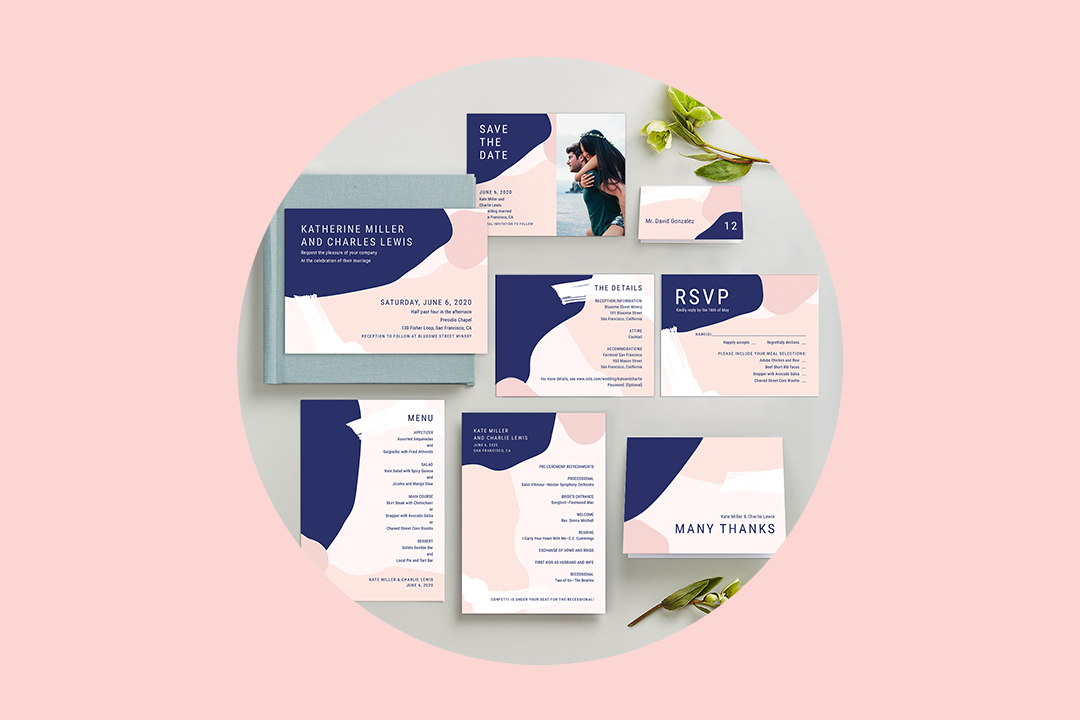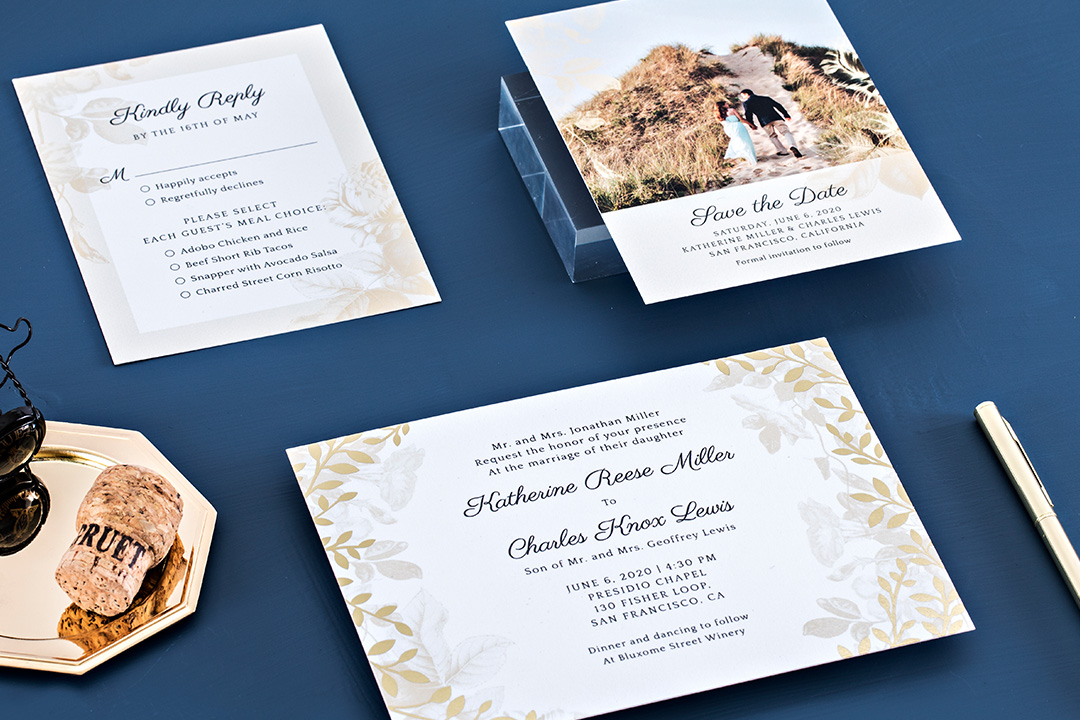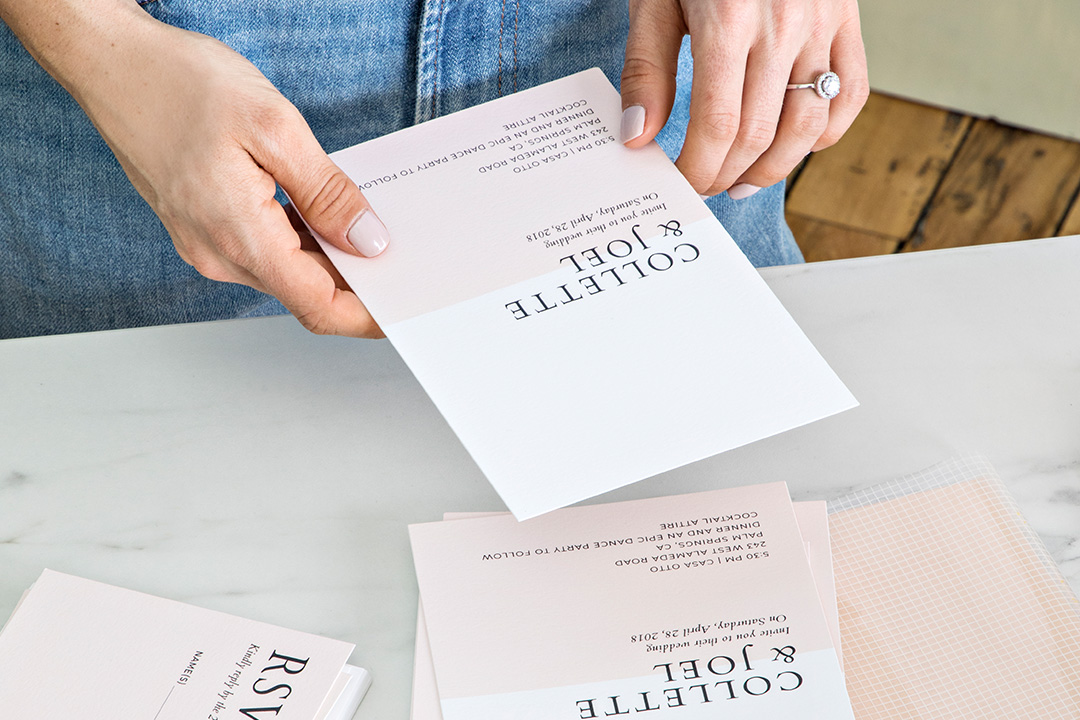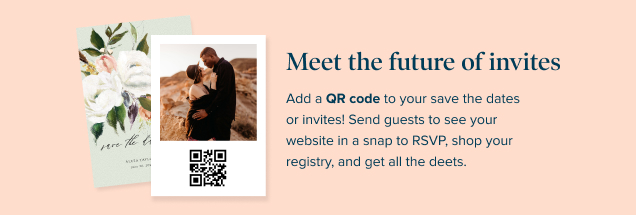- Expert advice/
- Invites & paper/
- Invitations/
- Complete Guide to Standard Wedding Invitations: Sizes, Formats, Orientation, & Etiquette
- Invitations
Complete Guide to Standard Wedding Invitations: Sizes, Formats, Orientation, & Etiquette
Learn more about options for wedding invitation sizes and orientations with traditional and alternative selections.
Last updated July 1, 2025

Shop invitations
View allTo answer the first question that popped into your head, yes, there are different wedding invitation sizes. In fact, there is a whole world of possibilities concerning how you invite your guests to your wedding and what your wedding invitation aesthetics look like in terms of shape, size, format, and color.
There are standard wedding invitation dimensions—typically a 5" x 7" rectangular card printed on high-quality cardstock. However, there are other unique invitation formats if you want a different size or shape (that go beyond a square or rectangle). You'll also have to consider whether vertical or horizontal orientation is appropriate.
Invitations feature formal wording that includes names of both the hosts and the couple along with important details, such as the wedding date, time, and location. While this traditional format remains the most popular choice, today's couples have numerous options for personalizing their invitations while maintaining proper invitation etiquette.
The invitation expertise team at Zola has all the wedding invitation logistics you need to consider so you can say "yes" to your perfect wedding invitation. Here's what you need to know and how Zola stationery services can help.
8 Wedding Invitation Sizes
Now that you have your budget, style, and what’s going on the invitation top of mind, you can settle on the right invite size. Here are your options:
1. Standard
The standard invitation size is a 5 x 7 inch rectangular card. Why? It's mainly because that's a standard size for envelopes. You can also mail 5" by 7" cards with standard postage—as long as it weighs under an ounce. However, most wedding invitation suites are heavier than that, so you'll need extra postage.
For a traditional look, standard invitations are vertical rectangular-shaped cards. However, nowadays, you will see almost as many horizontal options, too. And don't think that classic wedding invitations are dull. You can incorporate your aesthetic with fun fonts, colors, and even fancy edges for a classic wedding style.
With a standard size, you’ll have the most options to choose from when it comes to your wedding invitation style. A rectangular invitation exudes timeless elegance and should fit all the information you need and be able to include standard size detail and RSVP cards, too.
When addressing your invitation, hold the envelope horizontally. Write the address in the middle front, and affix your stamp in the upper right. A return address can go in the upper left corner or on the back of the envelope.

2. Tall
For a unique invite that can feature a lot of information, consider a four-by-nine inch invite. These are also known as thin or skim invites. They can portray a contemporary vibe and hold plenty of information. A tall card is useful if you don’t want to include a details card or if you’re having a destination wedding that requires more logistics.
3. Folded
With all the necessary info to be included on wedding cards, it’s not surprising that stationers have begun to offer folded invitation options. These can appear similar in style to that of a greeting card, with traditional invite wording on the front, and more details and sometimes photos on the inside.
Or, they can appear similar to a pamphlet with multiple panels. Although this type includes more info than a standard five-by-seven invite, it can be more cost-effective, since you won’t have to pay for additional details cards.
4. Booklets
Another way to get all the information in one concise format is with a booklet invitation. Booklets feature multiple pages that include the standard information, in addition to details, and maybe even portraits. Plus, they can be nicely tied up with ribbons and bows, clasped with modern grommets, or sewn together with string to match your style. It's not the standard invitation format, but a mini book can make an impression.
5. Square
Because square invitations offer a modern aesthetic and distinctive look, they can also give a unique presentation when displayed on a refrigerator or in a frame on a mantel. They also photograph beautifully for flat lays and wedding detail shots for contemporary or fashion-forward weddings.
Square wedding cards can be large or small, but consider five-by-five inches to be standard. This size and shape sends a contemporary vibe to your wedding guests. It can also feature chic borders, cool edges, and symmetric phrasing. If you like things to look clean and cool, this could be the right kind of invite for you.
However, there is one caveat about square invites—the postage costs more. While the square invitation visual impact relates to modern invitation shapes, you'll have to weigh your invitation budget considerations to see if the extra cost (currently $0.46) is worthwhile.

6. Petite Invites
You can also opt for a smaller invitation. Petite invites are cute, modern, and take up less space on the fridge. They’re a great option for couples who want a pocket-size invite that conveys just the necessary details. You can use the small space to direct guests to your wedding website for further information.
7. Large Invites
If there are petite invites, you can bet there are invites on the other end of the spectrum, too. Large invites are typically six-by-eight inches and can handle large fonts and loads of information. If your personality is big and bold, your wedding stationery might as well be, too.
8. Special Shapes
Circle, oval, diamond—oh my. Now, you can print your invite on paper of all shapes and sizes. An invitation in a cool shape can help communicate your theme. For instance, round invites can say casual or celestial, and oval invites can say elegant or feminine. Meanwhile, a totally out-there shape, such as an octagon can foreshadow geometric decor. Pick the shape that suits your wedding style, and include details cards that match.

Horizontal vs. Vertical Wedding Invitations
Wondering whether to choose landscape vs. portrait invitations? Both are available, and here are a few points to help you decide in our wedding invitation comparison:
Considerations for Vertical Invitations
- Follows traditional invitation design.
- Fits standard envelope sizes more easily.
- Creates an elegant, formal aesthetic.
- Works well with portrait-oriented photos.
- May feel more timeless and classic.

Considerations for Horizontal Invitations
- Provides more horizontal space for longer names or lengthy text.
- Creates a contemporary feel with a modern invitation layout.
- Works well for landscape-oriented photos or wide design elements.
- Can accommodate more text on fewer lines.
- May require special envelopes or folding techniques.

Should My Wedding Invitations Be Horizontal or Vertical?
- Depending on the size of your invitation, you could pay more in postage. However, a 5" x 7" will cost the same to mail, no matter whether the text is arranged horizontally or vertically.
- While a portrait orientation is more formal, a landscapt format can add a classy, modern element.
- Consider how you'd like to display your rectangular wedding invitations in a frame or on the fridge.
- Think about the other pieces within your wedding invitation suite. Blending portrait format invitations with landscape orientation enclosure cards adds an element of interest.
Postage Considerations for Mailing Wedding Invitations
Square vs. Rectangular Invitation Postage Comparison
While you may love the look of a square wedding invitation—indeed, they're lovely!—you also need to factor in extra costs due to the square shape. Even if your square invite weighs the same as a rectangluar one, the postage costs more.
Here's why square envelopes cost more to mail, according to the USPS:
- The USPS uses machines for mail sorting, and square envelopes can cause these machines to jam. That's why there are postal regulations for odd-shaped mail.
- Because of the possibility of damaging the sorting machines, square envelopes require hand-cancellation, meaning that it's more labor intensive for the post office. Hence, the additional postage requirements.
Check for current US postage rates, but as of July 2025, a rectangular envelope costs the standard postage rate of $0.78 to mail, whereas a square card costs $1.24. That's $0.46 additional postage per card (known as a non-machinable surcharge), without any weight overages. In addition to higher square envelope postage, hand cancellation can add a day or two to the mailing time.
Postage Considerations by Invitation Shape and Size
Beyond surcharges for square envelopes, having a full invitation suite with all the bells and whistles—detail cards, wax seals, and additional inner envelopes—can drive the postage price up. Invitation mailing costs are impacted by shape, weight, and thickness.
Here are USPS guidelines for wedding invitations according to weight:
- Standard forever stamps for wedding invitations are valid for up to one ounce.
- For letters over one ounce, the charge is currently an additional $0.29 per ounce over the first ounce. So, that's $1.07 for two ounces, and $1.36 for three.
- For 3.5 ounces, the total cost is $1.65.
If you have any questions about your postage cost or measuring postage for square invitations, you can take your wedding invitation suite (be sure you have all of the parts and pieces, including RSVP card postage and belly bands or stickers factored in), and have them weighed by USPS. They can help you have an easier mailing process and a cost-effective mailing.
Additionally, standard postage covers up to 1/4" of thickness, so you will have to pay more if you have a full wedding suite thicker than that. Although you want an eye-catching invitation design and standout wedding stationery, postage guideance may factor into choosing between square and regular invitations.
So, what's the most cost-effective invitation shape? It's rectangular. And if you're wondering, "Do rectangular invitations always require standard postage?" the answer is...maybe. As long as it's one ounce or less and no larger than 1/4" thick, you will still pay the standard rate.
If you can't decide on an orientation, just consider the wedding invitation shape pros and cons with cost. While a rectangular vs. square invitation display may be more impressive, your wedding invitation cost factors concerning postage may make the decision for you.

All-in-One Wedding Invitations vs. Traditional Multi-Piece Suites
Whether it's due to wedding budget concerns or ease of mailing, according to the wedding stationery experts at Zola, all-in-one invitations are continuing to grow in popularity. Here's what you need to know.
What Is an All-in-one Invitation Suite?
So, what are they? All-in-one wedding invitations (often referred to as pocket invites) are fold-out invitations that have more information—such as the wedding website details, wedding registry, response instructions, and accommodation information—all on one piece of cardstock.
A traditional wedding invitation suite includes an invitation with several wedding invitation inserts, like an RSVP card and transportation detail cards. We'll help you decide which is better for your wedding planning timeline, style, and budget.
Pros and Cons of Multi-piece Wedding Invitations vs. Pocket Invitations
Pro: A suite with wedding invitation inserts is more formal.
Looking to stick with tradition? An invitation suite with information cards is more formal for your big day.
Con: Wedding invitation packages can cost more.
Consolidated wedding invitations can help your keep within budget. After all, the more information and direction cards you add, the higher your wedding invitation costs will be.
Pro: A Zola invitation suite collection easily separates into essential parts
For guests who like to keep things organized, hanging your invitation on the fridge and taking the reception map with them will help.
Con: Multi-piece wedding suites aren't as planet-friendly.
Craving eco-friendly wedding invitations? Minimizing the parts and pieces will help keep waste at bay.
Pro: Receiving multiple pieces creates a great first impression.
Yes, you'll have to put more time into your invitation assembly. However, your guests will be impressed with enclosures wrapped in belly band invitations.
Con: The postage requirements may cost more.
Postage considerations are often on the mind of a couple. Therefore, having separate parts and pieces will weigh more than mailing an all-in-one invite.
The Complete Wedding Invitation Suite
While the “when” and “where” are the most important details of your wedding day, there is more information to include with your wedding invitations, which means, more paper parts. You can get just as creative with these invitation inserts as you did with your main invite.
Wedding enclosures can be included in a booklet or fold-out format, or have their own special card floating within (or on top of) the actual invitation.
Main Wedding Invitation
Invitation protocol says that the star of the show—your wedding invitation—should include the information necessary for folks to attend your big day.
When selecting your wedding invite size, what goes on the invitation plays an important role and can narrow down your choices. After all, you need enough space to display the essentials.
What information belongs on the main invitation vs. enclosure cards? Wedding stationery etiquette dictates that these non-negotiable pieces of information go on your invitations:
- Details Be sure to add the wedding date and time.
- Location This can be the name of the venue or property, plus the city and state. If it’s a private residence, list the address, but otherwise include this detail on the wedding website.
- Hosts’ names This can be the names of both sets of parents, one set of parents, or just the couple. The more names you need to list, the more space required.
If you want to include photos or more information, such as the reception location and time, you can choose a bigger invite size or a booklet invitation to ensure that everything fits and is legible.
Detail Enclosure Cards
Detail cards are the place for all the extra information you want to provide your guests. Depending on how extravagant your special day is, you may want one details card or several invitation inserts.
Here are a few things you may want on a separate card or cards:
Like the invite, enclosure cards can vary in shape or size. Stick to the same general shape as your invite so that it’s consistent, but make sure it’s smaller so guests aren’t confused. Your wedding invitation set should be mailed with both inner and outer envelopes—inner for the separate inserts and outer to hold everything.
Map
A custom illustrated map or travel card is both unique and personal. Especially popular for destination weddings, they give guests a better picture of where everything is taking place, from the ceremony spot to the reception venue and the pre-wedding games or post-wedding brunch. Plus, it adds an artistic touch to your invitation suite as a whole.
RSVP Card
Last, but not least, don’t forget the RSVP card—also known as response cards. This is how you will determine who’s coming and who can’t make it. A response card will not only provide answers to the “who” and “how many” questions, but also the “what they want to eat” question. These important details need to get to you, your planner, your caterer, and the venue.

Standard Wedding Invitation Materials and Printing Methods
Whether you're considering digital vs. printed invitations or are ready to splurge on luxury multi-piece wedding invitation suites by Zola, here are a few details to know.
Traditional Paper Types
Want to make an impression? Think about the type of paper for your inviations. Zola's premium paper options for both styles include:
- Cotton - Typically made of 100% cotton fibers, which can include recycled materials.
- Linen - Usually made from paper that mimics the look and feel of linen, often with a basket weave or crosshatch pattern.
- Cardstock - Constructed from medium to heavy-weight paper, often tree pulp, with a smooth, matte finish. Can also be double or triple thick.
Standard Printing Methods
Again, the look you want will determine the type of printing techniques you choose. Here are some options:
- Thermography - Creates a raised, textured, glossy finish on printed images or text by using heat to melt powdered resin.
- Letterpress - Relief printing, where raised surfaces, often made of metal type, are inked and pressed on paper to create an impression.
- Digital - Image directly from a digital file printed onto materials like paper or fabric using ink or toner.
- Engraving - Created by incising lines into a metal plate and transferring the ink from those lines on paper to create a print.
Inner and Outer Envelopes and Liners
Wedding invitations typically use both outer and inner envelopes, with liners often added to the inner envelope an elegant touch. Here's the breakdown:
- Outer envelope - Holds the guest's address, postage, and return address.
- Inner envelope - Lists the specific invitees within that household.
- Liners - Provide a decorative touch to the wedding invitation suite.
- Vellum overlays - Similar to a liner, but more transparent.
- Belly bands Gathers everything together so it doesn't slide around during transit.
Standard Colors and Finishes
Choose these based on preference, theme, and formality. Here are some standards:
- Common colors - Classic white, ivory, and light shades of pink or blue.
- Bolder colors - Jewel tones, or metallic gold and silver.
- Finishes - Range from matte and gloss to uncoated or textured.

FAQ About Standard Wedding Invitations
How much should I budget for wedding invitations?
Before committing to an invitation card size, consider your overall budget for invitations. Account for the number of invites and additional invitation inserts, in addition to postage (this can add up). Enclosure cards and heavy-weight paper can add extra postage. Unique wedding invitation sizes may also require special envelopes that could cost extra.
Keep in mind, your guest count dictates the cost of your contemporary wedding stationery the most. An additional 100 or even 50 guests can make it swing a couple of hundred dollars easily.
How do I pick the wedding motifs?
Have you nailed down the mood you’re going for on your wedding day? Whether you choose a specific color scheme or theme, land on a wedding style before you pick on an invitation size. Whether you're considering wedding monograms or a minimalistic card, the invitation should reflect your big day.
What's the difference between landsape and portrait wedding invitations?
Portrait format is the same as vertical wedding invites, and landscape orientation is the same as horizontal wedding cards.
How much extra postage do I need for square envelopes?
Do square invitations really cost more to mail? The answer is yes—currently $0.46 more. If you've been wondering, "Can I avoid extra postage fees with square invitations?" the answer is maybe. Simply place the square invite into a rectangular envelope to avoid the extra cost.
When should I order my wedding invitations?
Typically, you should order your invitation suite six-to-eight months before the wedding.
Do I need a save-the-date and invitation?
Save-the-date cards are nice, but not necessary. You can send a printed or digital save-the-date, which is nice so that folks can mark their calendars early.
What are the differences between digital and print invitations?
Digital is sent over the web, whereas printed are mailed. Both should contain the same information, and wedding stationery etiquette typically requires a printing on formal wedding invitations.
How to choose between horizontal and vertical wedding invitations?
Consider your text, preferences, and what speaks to you. Vertical wedding cards are traditional and classic, while horizontal wedding invites can have a more modern feel.
Does the type of invitation I choose impact my website or registry?
Looking to get the most out of Zola? All-in-one invitations, horizontal, or digital—all of them seamless integrates with your Zola wedding website. RSVP management also works the same, as long as you direct your guests to respond on your site.
How do I word invitations for different scenarios?
Zola has both a complete guide on traditional wedding invitation wording and formal invitation phrasing.
Are there cultural variations in standard wedding invitations?
Yes. These variations can manifest in design, language, and formality. For example, some cultures may prefer specific colors, symbols, or hand-delivered invitations, while others might include elements like calligraphy or multiple languages.
How far in advance should I mail square vs. rectangular invitations?
The hand-cancelling process takes an additional one to two days, which doesn't have much impact, unless you're on a tight timeline.

Zola: Your Place for Cohesive Wedding Stationery
An invitation is essential to provide your guests with the right information, but it can be much more than that. It’s the very first thing your guests will lay eyes on, so it should reflect you and your fiancé. The invite size can help show off your style and embody the overall aesthetic of your wedding day.
At Zola, you can find all you need for your stationery suite. From stunning invitations and enclosure cards to details like belly bands, wax seals, and vellum overlays, you can trust Zola's stationery service with your wedding's first impression to your guests.
Shop invitations
View all- Expert advice/
- Invites & paper/
- Invitations/
- Complete Guide to Standard Wedding Invitations: Sizes, Formats, Orientation, & Etiquette
Find even more wedding ideas, inspo, tips, and tricks
We’ve got wedding planning advice on everything from save the dates to wedding cakes.

